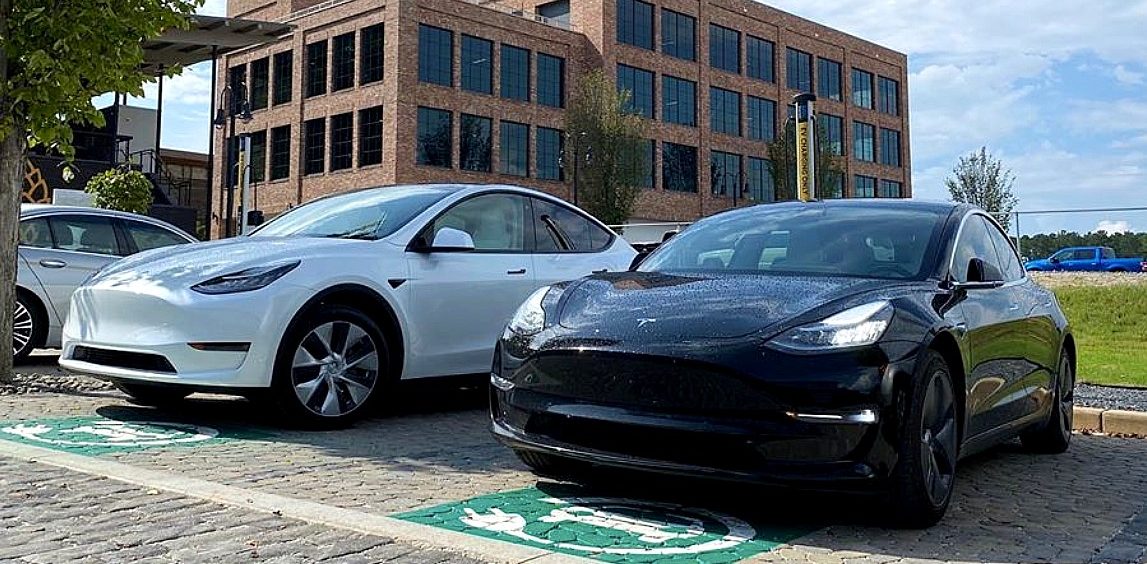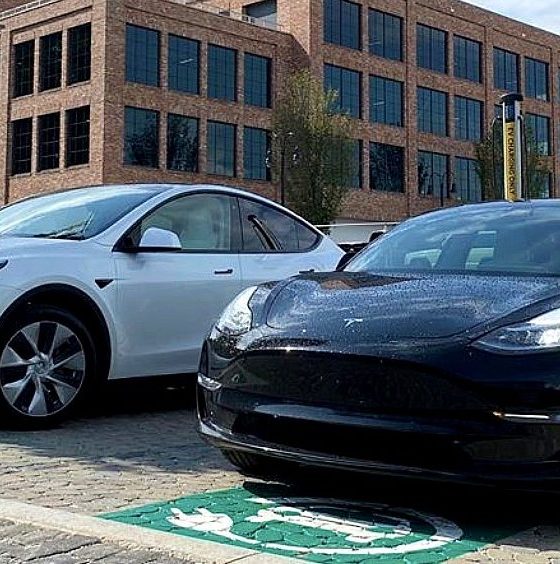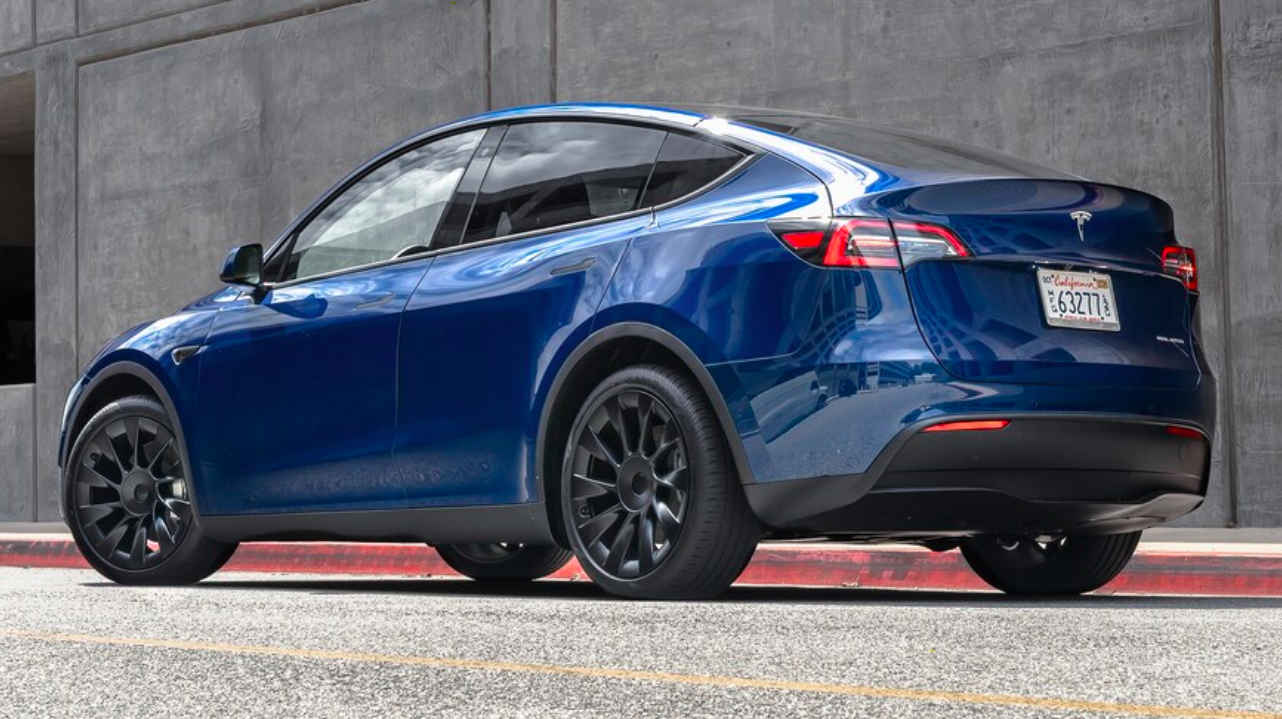

News
Tesla Model Y, Model 3 dominate 2021’s EV sales charts…and it’s not close
Tesla’s Model Y and Model 3 combined for the ideal one-two punch in the global EV sales charts through 2021 so far. A new list of the top 12 electric cars in the world was released earlier this week, and it shows Tesla’s lead in the sector is still as evident and as dominant as it ever was.
The list, put together by Car and Driver, shows that the Model Y has undoubtedly become Tesla’s star child with 76,429 units sold through the first half of 2021. Despite only being in Tesla’s lineup for a little over a year, the all-electric crossover has established itself as the most popular electric vehicle in the world today, surpassing its sibling Model 3, which really brought Tesla into the conversation of mass-market, affordable vehicles. The Model Y starts at $52,990 and is available in two different configurations: Long Range and Performance. Both builds of the vehicle pack Tesla’s Dual Motor All-Wheel-Drive powertrain, one of the most robust and advanced in the entire automotive sector today based on quality and performance metrics.
The Tesla Model Y. (Credit: MotorTrend)
The disruption the Model Y has caused to competing automakers is relevant and recognizable. More people bought Model Ys in the first half of the year than all other non-Tesla-produced electric cars combined. (This fact discounts the automakers, like Kia and Polestar, who do not report their sales figures to the public.)
The Model Y is also getting ready to break into the global automotive market’s best-seller list as well. According to the report, “the Y was incredibly close to unseating the Honda Pilot as the 25th-best-selling vehicle on the market as a whole.” In the coming years, as price parity battles begin to ween in favor of electric vehicle makers, the Model Y could break into the ranks of the global vehicle sales charts, displacing some of the most popular cars that have ever graced the market.
The Model Y wasn’t Tesla’s only contributor on the list, however. The Model 3, which has become a mainstay on EV sales charts since initial deliveries in Summer 2017, was the second-most sought-after vehicle in the global EV market. With 51,510 units sold, the Model 3 has kept its reputation as one of the best-selling EVs in the world through numerous competitors and so-called “Tesla Killers” who have failed to live up to their name. The Model 3 has been subjected to numerous price increases this year, just like its sibling Model Y, but still remains the automaker’s most affordable vehicle. The impressive combination of speed, range, and functionality has made the Model 3 one of the most intricate and important vehicles in the past few decades of American automobiles. Not only did the vehicle help Tesla become a household name, but it also solidified itself as one of the catalysts for more widespread EV adoption across the world.
Notables on the list include the Chevy Bolt EV and EUV in third with 20,288 units sold and the Ford Mustang Mach-E in fourth with 12,975 units.
It’s encouraging to see a list of vehicles that continues to expand and become more competitive through the years. With more automakers inevitably deciding to try their hand at producing an effective electric powertrain for consumers to buy, the market will only become more competitive, meaning the technology will continue to improve, and consumers will only benefit.

News
Tesla Giga Berlin draws “red line” over IG Metall union’s 35-hour week demands
Factory manager André Thierig has drawn a “red line” against reducing Giga Berlin’s workweek to 35 hours, while highlighting that Tesla has actually increased its workers’ salaries more substantially than other carmakers in the country.

Tesla Giga Berlin has found itself in a new labor dispute in Germany, where union IG Metall is pushing for adoption of a collective agreement to boost wages and implement changes, such as a 35-hour workweek.
In a comment, Giga Berlin manager André Thierig drew a “red line” against reducing Giga Berlin’s workweek to 35 hours, while highlighting that Tesla has actually increased its workers’ salaries more substantially than other carmakers in the country.
Tesla factory manager’s “red line”
Tesla Germany is expected to hold a works council election in 2026, which André Thierig considers very important. As per the Giga Berlin plant manager, Giga Berlin’s plant expansion plans might be put on hold if the election favors the union. He also spoke against some of the changes that IG Metall is seeking to implement in the factory, like a 35-hour week, as noted in an rbb24 report.
“The discussion about a 35-hour week is a red line for me. We will not cross it,” Theirig said.
“(The election) will determine whether we can continue our successful path in the future in an independent, flexible, and unbureaucratic manner. Personally, I cannot imagine that the decision-makers in the USA will continue to push ahead with the factory expansion if the election results favor IG Metall.”
Giga Berlin’s wage increase
IG Metall district manager Jan Otto told the German news agency DPA that without a collective agreement, Tesla’s wages remain significantly below levels at other German car factories. He noted the company excuses this by referencing its lowest pay grade, but added: “The two lowest pay grades are not even used in car factories.”
In response, Tesla noted that it has raised the wages of Gigafactory Berlin’s workers more than their German competitors. Thierig noted that with a collective agreement, Giga Berlin’s workers would have seen a 2% wage increase this year. But thanks to Tesla not being unionized, Gigafactory Berlin workers were able to receive a 4% increase, as noted in a CarUp report.
“There was a wage increase of 2% this year in the current collective agreement. Because we are in a different economic situation than the industry as a whole, we were able to double the wages – by 4%. Since production started, this corresponds to a wage increase of more than 25% in less than four years,” Thierig stated.
News
Tesla is seeing a lot of momentum from young Koreans in their 20s-30s: report
From January to November, young buyers purchased over 21,000 Teslas, putting it far ahead of fellow imported rivals like BMW and Mercedes-Benz.

Tesla has captured the hearts of South Korea’s 20s-30s demographic, emerging as the group’s top-selling imported car brand in 2025. From January to November, young buyers purchased over 21,000 Teslas, putting it far ahead of fellow imported rivals like BMW and Mercedes-Benz.
Industry experts cited by The Economist attributed this “Tesla frenzy” to fandom culture, where buyers prioritize the brand over traditional car attributes, similar to snapping up the latest iPhone.
Model Y dominates among young buyers
Data from the Korea Imported Automobile Association showed that Tesla sold 21,757 vehicles to the 20s-30s demographic through November, compared to BMW’s 13,666 and Mercedes-Benz’s 6,983. The Model Y led the list overwhelmingly, with variants like the standard and Long Range models topping purchases for both young men and women.
Young men bought around 16,000 Teslas, mostly Model Y (over 15,000 units), followed by Model 3. Young women followed a similar pattern, favoring Model Y (3,888 units) and Model 3 (1,083 units). The Cybertruck saw minimal sales in this group.
The Model Y’s appeal lies in its family-friendly SUV design, 400-500 km range, quick acceleration, and spacious cargo, which is ideal for commuting and leisure. The Model 3, on the other hand, serves as an accessible entry point with lower pricing, which is valuable considering the country’s EV subsidies.
The Tesla boom
Experts described Tesla’s popularity as “fandom culture,” where young buyers embrace the brand despite criticisms from skeptics. Professor Lee Ho-geun called Tesla a “typical early adopter brand,” comparing purchases to iPhones.
Professor Kim Pil-soo noted that young people view Tesla more as a gadget than a car, and they are likely drawn by marketing, subsidies, and perceived value. They also tend to overlook news of numerous recalls, which are mostly over-the-air software updates, and controversies tied to the company.
Tesla’s position as Korea’s top import for 2025 seems secured. As noted by the publication, Tesla’s December sales figures have not been reported yet, but market analysts have suggested that Tesla has all but secured the top spot among the country’s imported cars this year.
News
Tesla FSD fleet is nearing 7 billion total miles, including 2.5 billion city miles
As can be seen on Tesla’s official FSD webpage, vehicles equipped with the system have now navigated over 6.99 billion miles.

Tesla’s Full Self-Driving (Supervised) fleet is closing in on almost 7 billion total miles driven, as per data posted by the company on its official FSD webpage.
These figures hint at the massive scale of data fueling Tesla’s rapid FSD improvements, which have been quite notable as of late.
FSD mileage milestones
As can be seen on Tesla’s official FSD webpage, vehicles equipped with the system have now navigated over 6.99 billion miles. Tesla owner and avid FSD tester Whole Mars Catalog also shared a screenshot indicating that from the nearly 7 billion miles traveled by the FSD fleet, more than 2.5 billion miles were driven inside cities.
City miles are particularly valuable for complex urban scenarios like unprotected turns, pedestrian interactions, and traffic lights. This is also the difference-maker for FSD, as only complex solutions, such as Waymo’s self-driving taxis, operate similarly on inner-city streets. And even then, incidents such as the San Francisco blackouts have proven challenging for sensor-rich vehicles like Waymos.
Tesla’s data edge
Tesla has a number of advantages in the autonomous vehicle sector, one of which is the size of its fleet and the number of vehicles training FSD on real-world roads. Tesla’s nearly 7 billion FSD miles then allow the company to roll out updates that make its vehicles behave like they are being driven by experienced drivers, even if they are operating on their own.
So notable are Tesla’s improvements to FSD that NVIDIA Director of Robotics Jim Fan, after experiencing FSD v14, noted that the system is the first AI that passes what he described as a “Physical Turing Test.”
“Despite knowing exactly how robot learning works, I still find it magical watching the steering wheel turn by itself. First it feels surreal, next it becomes routine. Then, like the smartphone, taking it away actively hurts. This is how humanity gets rewired and glued to god-like technologies,” Fan wrote in a post on X.








